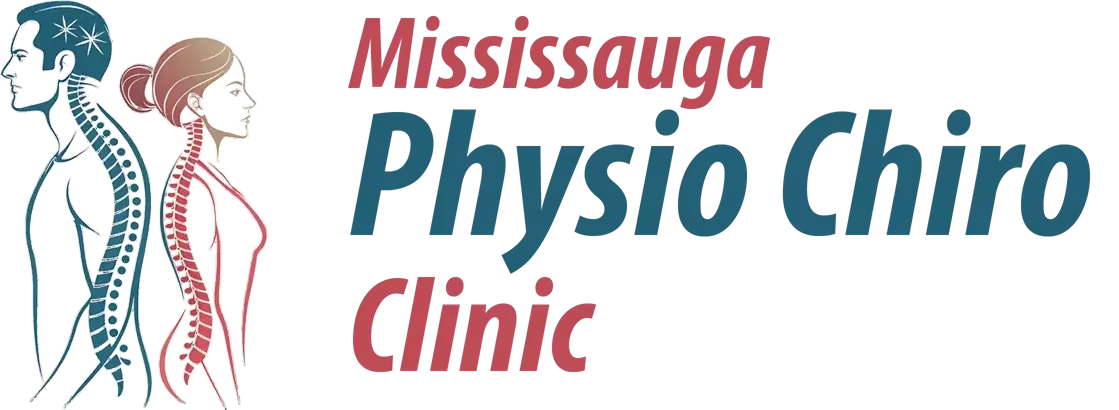Chiropractor for Concussion in Mississauga We recognize the importance of accessing specialized chiropractic care for concussion recovery in Mississauga. Our dedicated team employs evidence-based techniques to address neck pain, headaches, and balance issues resulting from concussions. We create personalized treatment plans focused on your unique recovery needs, incorporating gentle adjustments and vestibular therapy. Early intervention is crucial for effective healing, and we’re committed to supporting your journey back to peak health. By exploring our services, you’ll discover extensive strategies that promote brain healing and resilience against future injuries. About Our Physiotherapy and Chiropractic Services At Mississauga Physio Chiro Clinic, we offer extensive physiotherapy and chiropractic services tailored to address the unique needs of each patient, including those recovering from concussions. Our approach is evidence-based and focuses on the complexities of traumatic brain injuries, such as post-concussion syndrome. We recognize that symptoms like dizziness and headaches can greatly impact daily life, which is why we provide thorough headache management strategies alongside our core services. Our Best Physiotherapy & Chiropractic Clinic in Mississauga specializes in balance therapy and cognitive therapy to enhance recovery timelines and optimize neurorehabilitation. Through personalized assessment, we identify specific challenges each patient faces and develop targeted treatment plans to address them. We prioritize a patient-centered approach, ensuring that our physiotherapy and chiropractic services integrate seamlessly to promote overall well-being. By collaborating closely with each individual, we aim to empower them on their journey to recovery. Our goal is to not only alleviate symptoms but also to restore function and improve quality of life after a concussion. With our expert guidance, patients can navigate their recovery process with confidence and clarity. Concussions Explained: Causes and Impact on Brain Health Understanding concussions is fundamental for recognizing their causes and the significant impact they can have on brain health and overall well-being. A concussion is categorized as a mild traumatic brain injury, often resulting from a head injury, particularly in sports-related activities. It’s important to note that a concussion can occur without a loss of consciousness, making awareness of symptoms essential. The impact of a concussion extends beyond immediate symptoms, affecting neurocognitive function and potentially leading to vestibular dysfunction. This is why following a structured concussion protocol is fundamental for effective recovery. Post-injury rehabilitation often involves physical therapy for concussion, which helps individuals regain strength, balance, and cognitive function. Neurocognitive testing is also an important tool in evaluating recovery and determining when it’s safe to return to daily activities or sports. We must prioritize brain health by understanding the risks associated with concussions and ensuring proper evaluation and treatment. By doing so, we can help mitigate the long-term effects of these injuries and support ideal recovery for those affected. Identifying Concussion Symptoms and Knowing When to Get Help Recognizing concussion symptoms is fundamental for our health, as timely intervention can greatly influence recovery outcomes. When we experience head trauma, common concussion symptoms may include confusion, amnesia, dizziness after head injury, and visual disturbances. It’s important to be aware of these signs and understand that they can manifest differently in each individual. If we or someone we are familiar with displays these symptoms, seeking help promptly is essential. A concussion is a type of brain injury, and addressing it early can prevent further complications and facilitate a smoother recovery. Following return-to-play guidelines is particularly important for athletes, as returning too soon can exacerbate the injury. Occupational therapy can also play a key role in our recovery process, helping us regain cognitive and physical function. After a concussion, a gradual return to activity is recommended, allowing our brain time to heal properly. By staying vigilant and informed about concussion symptoms, we can guarantee our safety and well-being, as well as that of our loved ones. If we’re ever in doubt, consulting a healthcare professional is always the best course of action. How Chiropractic Care Aids in Concussion Recovery After identifying concussion symptoms and seeking appropriate medical help, exploring chiropractic care can be a valuable component of our recovery process. A chiropractor specializes in treating various aspects of concussion recovery, including neck pain, post-traumatic headaches, and balance problems. They often employ vestibular therapy to address dizziness and cognitive impairment, which can considerably impact our daily lives. Chiropractic adjustments may help restore proper alignment, relieving tension and reducing discomfort. Additionally, chiropractors can provide guidance on hydration and nutrition, emphasizing the importance of omega-3 for brain health, which supports cognitive function and overall recovery. As we navigate our return-to-work program, chiropractic care can play an essential role in helping us regain our strength and stability. By addressing both physical and cognitive challenges, we can work towards a more thorough recovery. Through personalized treatment plans, chiropractors focus on our specific needs, ensuring we feel supported throughout our journey. Treating Whiplash and Cervical Spine Issues Post-Concussion Whiplash and cervical spine issues are common complications following a concussion, often leading to persistent discomfort and mobility challenges that can hinder our recovery process. We understand that many individuals experience not just neck pain but also headaches, dizziness, blurred vision, and coordination issues as a result of these injuries. Sensitivity to light may also accompany these symptoms, further complicating our day-to-day activities. Chiropractic treatment can play an essential role in addressing these complications. Through targeted therapies, we can help restore proper alignment in the cervical spine, alleviating tension and promoting healing. Gentle adjustments aim to improve mobility and reduce pain, making it easier for us to manage our symptoms. Additionally, chiropractic care can enhance nervous system functioning, which may help mitigate issues like dizziness and coordination problems. As we navigate our recovery journey, it’s important to work closely with our chiropractor to develop a personalized treatment plan that addresses our unique needs. By focusing on both the whiplash and concussion aspects, we can optimize our healing and regain the quality of life we deserve. Chiropractic Techniques for Relieving Post-Traumatic Headaches Following the challenges of managing whiplash and cervical spine issues, many of us also face the debilitating effects of post-traumatic
Chiropractor for Postural Imbalances
Chiropractor for Postural Imbalances in Mississauga We’re here to help you tackle postural imbalances in Mississauga, a common issue affecting many individuals due to poor ergonomics and lifestyle habits. Our Chiropractor for Postural Imbalances provides extensive chiropractic care, including thorough assessments, personalized adjustments, and tailored rehabilitation exercises designed to improve spinal health and overall well-being. We recognize the strain that poor posture places on your body, often leading to chronic pain. By focusing on education about posture and ergonomics, we empower you to make lasting changes. Discover the supportive techniques and strategies we offer to enhance your posture and relieve discomfort, ensuring you’re on the path to a balanced life. About Our Physiotherapy and Chiropractic Services At Mississauga Physio Chiro Clinic, we offer extensive physiotherapy and chiropractic services designed to address postural imbalances and enhance overall well-being. Our approach begins with a thorough postural assessment, allowing us to identify any spinal misalignment and understand the unique needs of each patient. By focusing on postural correction, we help restore ideal body alignment, which is essential for pain relief and functional movement. Incorporating core strengthening exercises and mobility exercises into our treatment plans, we empower our patients to improve their posture and overall physical health. Our physiotherapy and chiropractic services include personalized chiropractic adjustments tailored to alleviate discomfort and promote proper alignment. Additionally, we believe that postural education is vital for long-term success. We work closely with our patients to teach them about the importance of maintaining good posture in their daily lives, ensuring they have the tools to make lasting changes. Our Top Physiotherapist & Chiropractor in Mississauga is committed to supporting each individual on their journey to better health, helping them achieve improved posture and enhanced quality of life. Together, we can tackle postural imbalances and foster a healthier, more balanced lifestyle. Postural Imbalances Explained: Causes and Long-Term Effects Postural imbalances can arise from various factors, including poor ergonomics, muscle weakness, and lifestyle habits, and understanding their causes is essential for preventing long-term effects on our health. When we experience postural dysfunction, such as forward head posture or rounded shoulders, it often stems from a combination of core weakness and muscle tightness. These issues lead to musculoskeletal imbalances that can notably impact our daily lives. Over time, the consequences of neglecting our postural awareness can manifest as chronic back pain and neck pain. We might not realize it, but our everyday activities—like prolonged sitting or improper lifting—can create postural strain that exacerbates these issues. As we continue to engage in these habits, we may find ourselves trapped in a cycle of discomfort and dysfunction. It’s vital for us to recognize these patterns and take proactive steps to address them. By improving our posture and strengthening our core, we can alleviate muscle tightness and reduce the risk of developing further complications. With a focus on education and awareness, we can work together to create healthier habits that support our overall well-being. Recognizing Different Types of Postural Dysfunction Many of us may not realize the various types of postural dysfunction that can affect our daily lives, leading to discomfort and long-term health issues. Recognizing these issues is essential for our overall well-being. Common postural deviations include poor posture, which often manifests as a rounded back or slumped shoulders. This can result in conditions like kyphosis, where the upper spine curves excessively. We might also encounter lordosis, characterized by an exaggerated inward curve of the lower back, or scoliosis, which involves an abnormal lateral curvature of the spine. Text neck is another prevalent issue, stemming from prolonged smartphone use, causing strain on our neck and upper back. Additionally, muscle asymmetry can develop, leading to joint stiffness and postural fatigue, making it harder for us to maintain an upright position. Ergonomics plays a significant role in mitigating these issues, as proper workstation setup can help us avoid postural dysfunction. By being aware of these types of postural dysfunction, we can take proactive steps to improve our posture and, consequently, our quality of life. How Chiropractic Care Supports Postural Correction Recognizing the signs of postural dysfunction is the first step towards improvement, and chiropractic care offers a targeted approach to support postural correction and enhance overall spinal health. As we work with a chiropractor, we can benefit from various techniques designed to restore spinal stability and improve our posture. Through manual therapy, our chiropractor can address muscle compensation patterns that often develop due to poor posture. This hands-on approach helps alleviate tension and promotes better alignment. Additionally, postural therapy allows us to engage in posture rehabilitation, focusing on specific exercises tailored to our needs. Incorporating flexibility exercises helps to improve our range of motion, while strengthening exercises bolster the muscles necessary for maintaining proper posture. Our chiropractor can also advise us on workplace ergonomics, ensuring our environments support healthy postural habits. Assessing Postural Misalignments and Muscle Imbalances Evaluating postural misalignments and muscle imbalances is essential for identifying the underlying issues that contribute to discomfort and hinder our overall well-being. By examining postural misalignments, we gain insight into how spinal curvature and muscle imbalances affect our daily lives. A thorough biomechanical evaluation allows us to understand our movement patterns and pinpoint areas requiring attention. We often encounter individuals with compromised postural stability, leading to chronic pain and reduced functionality. Through careful analysis, we can develop tailored posture rehabilitation programs that focus on postural retraining and enhancing neuromuscular control. This approach not only addresses immediate discomfort but also promotes long-term holistic posture correction. It’s important to remember that each body is unique, and our strategies must reflect that individuality. By collaborating with a chiropractor, we can engage in a detailed assessment that reveals the root causes of our postural challenges. Together, we’ll work towards restoring balance and improving our overall posture, which is crucial for our health and well-being. By prioritizing these evaluations, we empower ourselves to take proactive steps in preventing future issues and achieving ideal posture. Chiropractic Approaches to Forward Head Posture and Text
Chiropractor for Kyphosis
Chiropractor for Kyphosis in Mississauga If you’re seeking a chiropractor for kyphosis in Mississauga, we’re here to help. We focus on thorough assessments to understand your specific condition. Our skilled team provides personalized treatment plans, including spinal adjustments and therapeutic exercises, aimed at improving your posture and alleviating pain. We also emphasize postural education and ergonomic adjustments to support your daily activities. Through our holistic approach, we aim to enhance your overall well-being and quality of life. To discover how we can assist you further, we encourage you to explore the various options we offer for effective kyphosis management. About Our Physiotherapy and Chiropractic Services At Mississauga Physio Chiro Clinic, we consistently provide extensive physiotherapy and chiropractic services tailored to address the unique needs of individuals with kyphosis. We recognize that kyphosis can lead to discomfort and mobility challenges, which is why our approach focuses on postural correction and holistic spine care. Our Best Physiotherapy and Chiropractic Services in Mississauga include chiropractic adjustments and spinal manipulation to help realign the spine, relieving pain and improving function. We emphasize pain management strategies that empower our patients to take control of their health. Through targeted rehabilitation exercises and mobility exercises, we aim to strengthen the muscles supporting the spine, enhancing overall stability. We also prioritize postural awareness, teaching our patients how to maintain proper posture in daily activities to prevent further complications. Our team is dedicated to creating personalized treatment plans that not only address current symptoms but also promote long-term wellness. By focusing on the interconnectedness of the body, we endeavor to provide an all-encompassing approach to managing kyphosis. Together, we can work towards improving your quality of life and supporting your journey to better spinal health. Kyphosis Explained: Causes and Different Types Kyphosis, often characterized by an exaggerated forward curvature of the spine, can arise from various causes and presents in different forms, each requiring specific attention and management strategies. One common type is hyperkyphosis, where the spinal curvature is excessive, leading to a rounded back appearance. This condition can often be exacerbated by postural kyphosis, which results from poor posture habits over time. Congenital kyphosis is another form, originating from spinal deformities present at birth, while degenerative disc disease can contribute to kyphosis as the spine ages and discs deteriorate. All these forms of kyphosis can lead to vertebral compression and contribute to significant back pain, impacting daily activities and overall quality of life. Understanding the different types of kyphosis is essential for effective management. We need to recognize that each type may require tailored treatment approaches, including chiropractic care, physical therapy, or, in severe cases, surgical intervention. By identifying the underlying causes and types of kyphosis, we can adopt proactive measures to alleviate discomfort and improve spinal health, fostering better posture and mobility for ourselves and others. Identifying the Signs and Symptoms of Kyphosis Recognizing the signs and symptoms of kyphosis is important for addressing this condition effectively and can help us understand when to seek professional assistance. Kyphosis often manifests as a noticeable hunched posture, which may stem from poor posture over time or conditions like Scheuermann’s kyphosis. We might experience upper back pain or thoracic pain, especially after long periods of sitting or standing. Stiffness in the spine can also be a common symptom, accompanied by muscle tightness in the surrounding areas. These sensations can lead to a postural imbalance, making it even more challenging to maintain proper alignment. It’s essential to pay attention to these signs, as spinal misalignment can worsen if left untreated. If we notice a combination of these symptoms, it could indicate that kyphosis is developing or worsening, and seeking professional help would be a wise decision. Early intervention can make a significant difference in managing the condition, improving our overall quality of life. By being proactive about recognizing these signs, we can take important steps towards better spinal health and well-being. The Role of Chiropractic Care in Kyphosis Management Chiropractic care plays an essential role in managing kyphosis by addressing spinal alignment issues and promoting better posture through tailored treatment plans. As chiropractors, we focus on extensive kyphosis treatment strategies that begin with a thorough spinal assessment. This allows us to identify any misalignments and develop a customized approach to care. Manual therapy is a core component of our treatment, as it helps in spinal correction and alleviating discomfort. We often incorporate postural therapy to educate patients about maintaining proper posture throughout their daily activities. In addition, we recommend flexibility exercises and strengthening exercises to enhance muscle support around the spine, which is vital for long-term improvement. In addition to hands-on treatment, we emphasize the importance of ergonomic adjustments in the workplace and home environments to minimize strain on the back. By integrating physiotherapy techniques, we can additionally facilitate recovery and promote mobility. Overall, our goal is to empower our patients with the knowledge and tools they need to manage their kyphosis effectively and improve their quality of life. Together, we can work towards achieving a healthier, more aligned spine. Spinal Misalignment and Postural Imbalances: Chiropractic Assessment Identifying spinal misalignments and postural imbalances is essential for developing an effective treatment plan tailored to each patient’s unique needs. During a chiropractic assessment, we evaluate the spine and posture to determine the presence of conditions like kyphosis, which can manifest as thoracic kyphosis or cervical kyphosis. By examining the curvature of the spine, we can identify areas of spinal instability that may contribute to discomfort or pain. Our assessment also considers how postural imbalances affect body mechanics, particularly in relation to daily activities and workplace ergonomics. Poor posture can lead to further complications, including muscle strain and increased risk of injury. Through a thorough evaluation, we can pinpoint specific areas that require attention. Once we identify these misalignments, we can devise a personalized treatment plan that may include chiropractic adjustments, physical therapy, and recommendations for improving body mechanics and ergonomics at work. By focusing on these elements, we aim to support our
Chiropractor for Rib Pain
Chiropractor for Rib Pain in Mississauga If you’re seeking a chiropractor for rib pain in Mississauga, we specialize in tailored care that addresses the root causes of discomfort. Our Top Mississauga Physiotherapy & Chiropractic Services focuses on hands-on techniques to improve alignment and relieve pain associated with conditions like intercostal strains and costochondritis. We combine chiropractic adjustments with gentle stretches and strengthening exercises to enhance mobility and reduce tension. Our extensive approach guarantees we address both immediate relief and long-term wellness. We recognize each person’s unique situation and are here to help you on your journey to recovery and comfort. Stay with us to discover more about how we can assist you. About Our Physiotherapy and Chiropractic Services At Mississauga Physio Chiro Clinic, we specialize in providing extensive physiotherapy and chiropractic services tailored to effectively address rib pain and enhance overall well-being. Rib injuries and dysfunction can notably impact our daily lives, causing discomfort and limiting movement. Our team is dedicated to evaluating and treating these issues through a thorough approach. We employ rib mobilization techniques to facilitate movement and alleviate pain. Our physical therapy sessions focus on restoring strength and flexibility, addressing muscle tension that may arise from postural strain or previous injuries. We believe in a personalized treatment plan, guaranteeing that each individual’s needs are met. Incorporating chiropractic care, we work to realign the spine and rib cage, which can be vital in managing rib pain effectively. By combining physiotherapy and chiropractic services, we aim to provide holistic pain management solutions that promote healing and recovery. Our empathetic approach guarantees that we listen to your concerns, guiding you through each step of your recovery journey. Together, we’ll empower each other to regain mobility and improve overall health, allowing us to enjoy life without the burden of rib pain. Rib Pain Explained: Causes and Symptoms Understanding rib pain involves recognizing the various causes and symptoms that can arise, which is key to finding effective treatment and relief. Rib cage discomfort can stem from a range of conditions, including intercostal pain, which occurs when the muscles between the ribs become strained or irritated. One common issue we encounter is costochondritis, characterized by inflammation of the cartilage connecting the ribs to the breastbone. We may also experience rib strain, often due to overexertion or injury, leading to sharp pain and a dull ache in the thoracic area. This discomfort can greatly restrict movement, making everyday activities challenging. Additionally, rib inflammation can cause pain with deep breathing, making it feel difficult to take a full breath. Recognizing these symptoms early can help us address the underlying issues more effectively. Whether it’s the sharp pain during certain movements or the persistent dull ache that lingers, understanding the root cause is essential in managing rib pain. By being aware of these conditions, we can take proactive steps toward relief and recovery, ensuring our rib health remains a priority. Chiropractic Solutions for Rib Pain Relief Chiropractic care offers a range of effective solutions for relieving rib pain, as it targets the underlying musculoskeletal issues contributing to discomfort. We recognize that conditions like rib sprains, rib fractures, and dislocated ribs can lead to significant pain and limitations in daily activities. By utilizing hands-on techniques, we can help restore proper alignment and function to the thoracic region. In cases of intercostal neuralgia, where nerve pain occurs between the ribs, our approach may include specialized adjustments and osteopathic treatment to alleviate discomfort. We also address muscle spasms and rib cartilage injuries that can result in pain with twisting movements, enhancing mobility and reducing tension. Incorporating massage therapy into our treatment plans can further aid in muscle relaxation and pain relief. We tailor our chiropractic solutions to each individual’s needs, recognizing that conditions like thoracic outlet syndrome may require a thorough approach to guarantee peak recovery. Through our compassionate care, we aim to empower our patients to regain their quality of life and manage rib pain effectively. Together, we can explore the best treatment options available for your specific situation. Understanding the Common Causes of Rib Pain Many factors can contribute to rib pain, including injuries, underlying medical conditions, and even postural issues, making it important for us to identify the root cause for effective treatment. One common cause is a broken rib or bruised rib, often resulting from trauma or accidents. Costal pain may also arise from conditions like Tietze syndrome, which involves inflammation of the cartilage connecting the ribs to the sternum, leading to noticeable sternum pain. Additionally, we shouldn’t overlook thoracic radiculopathy, where nerve compression in the thoracic spine can radiate pain to the rib area. Poor posture can exacerbate these issues, leading to myofascial pain as the body compensates for misalignments. Inflammation from various conditions can further heighten discomfort, making it crucial for us to understand these potential causes. Recognizing the specific source of rib pain is essential for selecting the right treatment approach. By addressing these issues holistically, we can work towards alleviating symptoms and promoting overall well-being. If you’re experiencing rib pain, consulting with a qualified chiropractor can help us navigate these complexities and find the most effective relief strategies. Recognizing Rib Misalignment and Dysfunction How can we identify rib misalignment and dysfunction, which often contribute to persistent discomfort and restricted movement? Rib subluxation can manifest in various ways, including chest wall pain and breathing difficulties. We might experience pain with coughing or during deep breathing, indicating sternocostal joint pain or costovertebral joint pain. When evaluating ourselves, we should pay attention to our posture. Poor posture can lead to muscle imbalance, exacerbating rib misalignment. If we notice tightness in the chest or discomfort during stretching exercises, these may be signs that our ribs are not properly aligned. Additionally, deep breathing pain can signal underlying rib dysfunction, making it essential to recognize these symptoms early. It’s important to address these issues before they lead to chronic conditions. By focusing on posture correction and integrating appropriate stretching exercises into our routine, we can alleviate
Chiropractor for Vertigo
Chiropractor for Vertigo in Mississauga We specialize in chiropractic care for vertigo in Mississauga, focusing on effective treatment tailored to your individual needs. Our approach includes spinal adjustments and vestibular rehabilitation therapy, which helps address misalignments that can contribute to dizziness and balance issues. By evaluating your specific symptoms and history, we collaborate with you to enhance stability and overall quality of life. Additionally, we offer personalized exercises and education to empower you in managing your condition. For those interested in understanding more about our methods and how they can aid recovery, there’s much more to discover. About Our Physiotherapy and Chiropractic Services At Mississauga Physio Chiro Clinic, we specialize in providing extensive physiotherapy and chiropractic services tailored to address a variety of conditions, including vertigo. Vertigo often stems from vestibular dysfunction, an issue that can greatly impair balance and coordination. Our Expert Physiotherapist & Chiropractor in Mississauga employs a thorough approach to treat balance disorders through targeted vestibular rehabilitation therapy (VRT), which is designed to alleviate symptoms associated with head movement sensitivity and inner ear disorders. We recognize that each patient’s experience with vertigo is unique, and our physiotherapy and chiropractic services are customized to meet individual needs. By integrating vestibular rehabilitation techniques, we aim to enhance patients’ stability and overall function. Our multidisciplinary team collaborates closely with audiology specialists to guarantee a complete understanding of the underlying causes of vestibular dysfunction. This collaboration enables us to create effective treatment plans that not only address the symptoms of vertigo but also target the root causes of coordination issues. Our goal is to empower patients to regain their balance and confidence, ultimately improving their quality of life. Whether you’re experiencing mild dizziness or more severe vertigo, we’re here to help you navigate your path to recovery. Vertigo Explained: Causes, Symptoms, and Triggers Vertigo, a sensation of spinning or dizziness, can arise from various underlying causes, including vestibular disorders, migraines, and certain medications. Our understanding of vertigo encompasses symptoms like dizziness, unsteadiness, and a spinning sensation that can greatly impact daily life. The vestibular system, responsible for balance and spatial orientation, can be affected by conditions such as benign paroxysmal positional vertigo (BPPV), Meniere’s disease, and vestibular neuritis, leading to episodes of vertigo. Additionally, cervical spine issues can contribute to vertigo through nerve compression or dysfunction, while anxiety can exacerbate sensations of dizziness, creating a cycle of distress. Motion sickness is another common trigger, where certain movements can provoke the spinning sensation. We recognize the importance of identifying individual triggers and underlying causes to address vertigo effectively. By understanding the complexities of this condition, we can better support those experiencing it. Early recognition of symptoms and seeking appropriate care is essential for managing vertigo and improving overall quality of life. Chiropractic Solutions for Vertigo: How It Helps Chiropractic care offers a unique approach to addressing vertigo by targeting underlying cervical spine issues and optimizing the function of the nervous system, which can greatly alleviate symptoms. As chiropractors, we recognize that many cases of vertigo stem from cervicogenic dizziness, where cervical spine dysfunction affects balance and proprioception. By employing specific chiropractic solutions, we can correct misalignments, enhance joint mobility, and improve overall function. A thorough assessment often includes vestibular testing to identify the precise nature of balance problems. Once identified, we may employ techniques such as the Epley maneuver, which can help reposition displaced inner ear crystals, alleviating dizziness. Our focus on restoring cervical spine alignment can also reduce postural instability, further enhancing stability and coordination. Moreover, regular chiropractic adjustments can support the nervous system, promoting better communication between the brain and the body’s balance systems. This holistic approach not only addresses the immediate symptoms of vertigo but also contributes to long-term wellness. By integrating neurotology principles, we aim to provide extensive care that empowers our patients to regain control over their balance and improve their quality of life. Types of Vertigo Chiropractors Can Treat Recognizing the various types of vertigo we can treat is essential for developing effective management strategies tailored to each patient’s needs. We often encounter positional vertigo, such as Benign Paroxysmal Positional Vertigo (BPPV), which can lead to episodes of intense dizziness triggered by specific head movements. Peripheral vertigo, often linked to conditions like ear infections or labyrinthitis, presents with symptoms of lightheadedness and nystagmus. Central vertigo, arising from neurological issues, may manifest as more prolonged episodes of disequilibrium. Another common type we address is vestibular migraine, where dizziness accompanies headache symptoms. Each type of vertigo requires a nuanced approach to treatment. To aid in recovery, we may recommend exercises like the Brandt-Daroff exercises, designed to alleviate symptoms by promoting vestibular adaptation. By distinguishing between these types of vertigo, we can better assess individual cases and create personalized care plans. Understanding the root cause of a patient’s vertigo allows us to implement the most effective chiropractic interventions, ensuring ideal outcomes and improved quality of life. Cervical Spine Misalignment and Its Connection to Vertigo Misalignment of the cervical spine can greatly contribute to the onset and exacerbation of vertigo symptoms, highlighting the importance of a thorough assessment during treatment. When the cervical spine is misaligned, it can lead to increased tension and stress on the vestibular nerve, which plays a significant role in maintaining balance and spatial orientation. Moreover, cervical spine misalignment may affect the inner ear’s fluid dynamics, potentially causing inner ear fluid imbalance. This imbalance is often a key factor in various types of vertigo, including visual vertigo. Individuals with a history of head trauma or concussions may experience exacerbated symptoms, as these injuries can further disrupt cervical alignment and vestibular function. Additionally, misalignment can trigger panic attacks in some patients, compounding the vertigo experience and leading to a cycle of anxiety and dizziness. While an ENT specialist may utilize caloric testing to evaluate vestibular function, addressing cervical spine misalignment through targeted chiropractic care can be an effective complementary approach. By correcting these misalignments, we can help alleviate vertigo symptoms and improve overall balance and well-being.
Chiropractor for Torticollis
Chiropractor for Torticollis in Mississauga If we’re seeking a chiropractor for torticollis in Mississauga, we’ll find specialized care committed to restoring neck mobility and relieving muscle tension. Torticollis, or ‘twisted neck,’ can greatly impact our daily activities, but chiropractic adjustments focus on aligning the cervical spine and addressing underlying muscle tightness. Our Top Physiotherapy & Chiropractic Clinic in Mississauga can expect tailored treatment plans that combine manual therapy, stretching exercises, and lifestyle modifications. With early intervention, we can improve both function and quality of life. There’s much more to discover about how these treatments can support our journey towards wellness and comfort. About Our Physiotherapy and Chiropractic Services At Mississauga Physio Chiro Clinic, we offer extensive physiotherapy and chiropractic services tailored to address the unique needs of individuals suffering from torticollis. We recognize that neck pain and muscle tightness can greatly impact daily life, and our dedicated team is here to help. Our approach focuses on identifying the root causes of cervical spine dysfunction, allowing us to create personalized treatment plans. We utilize a combination of manual therapy, therapeutic exercises, and postural correction techniques to alleviate discomfort and restore mobility. Our stretching exercises are designed to enhance flexibility and reduce tension in the neck muscles. Additionally, we incorporate heat therapy to promote relaxation and improve blood circulation, which can further aid in recovery. For those dealing with pediatric torticollis, our specialized treatment protocols guarantee that children receive care suited to their developmental needs. We’re committed to providing compassionate care, empowering our patients with the knowledge and tools needed for their recovery journey. Together, we can navigate the path to improved neck health, enabling you or your child to regain comfort and freedom of movement. Let’s work together to achieve your wellness goals. Torticollis Explained: How It Affects Neck Health and Mobility Torticollis, often referred to as ‘twisted neck,’ can greatly disrupt neck health and mobility, leading to discomfort and limitations in daily activities. This condition often manifests through neck stiffness and limited neck movement, making everyday tasks increasingly challenging. In many cases, it results from muscle contracture that causes abnormal head posture, where the head tilts or rotates involuntarily. For those experiencing neck muscle spasms, torticollis can create a persistent cycle of pain and discomfort, substantially impacting quality of life. In the case of neurological torticollis, underlying neurological factors contribute to this muscle dysfunction, sometimes leading to facial asymmetry. Understanding these symptoms is essential for effective treatment. Chiropractic care offers a holistic approach to managing torticollis. By addressing the misalignments in the cervical spine and working on muscle balance, we can help improve mobility, reduce pain, and restore normal head posture. Through targeted chiropractic techniques, we can alleviate the discomfort associated with this condition and support the overall health of our neck. If you’re struggling with torticollis, seeking chiropractic care may be a valuable step toward regaining your neck’s mobility and comfort. Different Types of Torticollis and Their Underlying Causes How can we better understand the various types of torticollis and their underlying causes to effectively address this complex condition? Torticollis, often referred to as wry neck, can be classified into congenital and acquired types. Congenital torticollis usually arises due to birth trauma, where tightness in the neck muscles leads to a cervical muscle imbalance. On the other hand, acquired torticollis can develop later in life, often stemming from factors like spinal misalignment, nerve compression, or even stress-induced muscle tension. Within acquired torticollis, we find muscular torticollis, stemming from muscle strain, and postural torticollis, often linked to poor posture and repetitive movements. Each type has distinct characteristics, yet they share common underlying causes that may contribute to neck discomfort and restricted movement. By recognizing these causes, we can tailor our approach to treatment, address the root issues, and promote healing. Understanding these nuances not only helps us identify the specific type of torticollis but also empowers us to choose the most effective interventions, ensuring a holistic approach to recovery. Recognizing the Symptoms of Torticollis: When to Seek Help Recognizing the symptoms of torticollis is vital, as timely intervention can greatly improve our overall well-being and comfort. Torticollis can manifest in various forms, including spasmodic torticollis and acute torticollis. We may notice a distinct head tilt or an asymmetric neck position, often due to involuntary muscle contractions affecting the sternocleidomastoid muscle. In cases of idiopathic cervical dystonia, we might experience unpredictable muscle spasms that lead to muscle weakness and discomfort. It’s important to pay attention to trigger points that can exacerbate our symptoms, especially if we have chronic torticollis. This condition can cause not only physical discomfort but also emotional distress as it interferes with daily activities. If we experience persistent neck stiffness, sudden pain, or a noticeable tilt in our head, it’s essential to seek help promptly. Early intervention can prevent the progression of symptoms and enhance our quality of life. By recognizing these signs, we can take proactive steps toward managing our condition, ensuring that we receive the appropriate care and support needed to regain our comfort and mobility. The Benefits of Chiropractic Care for Torticollis Relief Exploring chiropractic care can offer us significant relief from the discomfort associated with torticollis, helping to restore mobility and improve our overall quality of life. This holistic approach addresses issues like muscle tightness and cervical misalignment, which are common in individuals suffering from this condition. By working with a chiropractor, we can benefit from tailored treatment plans that may integrate physical therapy, neck strengthening exercises, and even modalities like cold therapy and acupuncture. Chiropractic care focuses on aligning the spine and improving overall function, which can be especially helpful for those with neurological disorders that contribute to torticollis. We might also explore additional supportive strategies such as bracing and occupational therapy to enhance our recovery process. Through regular chiropractic adjustments and exercises, we can progressively alleviate pain and enhance our neck’s range of motion. The compassionate and knowledgeable guidance of a chiropractor empowers us to take control of our health, fostering
Chiropractor for Pinched Nerves
Chiropractor for Pinched Nerves in Mississauga If you’re seeking a chiropractor for pinched nerves in Mississauga, we’re here to help. Our Expert Physiotherapist & Chiropractor in Mississauga specializes in providing effective nerve pain relief through tailored treatments, including spinal decompression and adjustments. We acknowledge the discomfort that comes from conditions like sciatica or herniated discs. Our thorough approach encompasses holistic evaluations and personalized therapy, ensuring we target the root causes of your pain. With practices like nerve gliding exercises and ergonomic consultations, we aim to enhance your mobility and overall spinal health. Stick with us, and you’ll discover further insights on how we can support your recovery journey. About Our Physiotherapy and Chiropractic Services At Mississauga Physio Chiro Clinic, we offer a thorough range of physiotherapy and chiropractic services designed to address pinched nerves and promote overall wellness. Our team understands that nerve compression and entrapment can greatly impact daily life, causing discomfort and limiting mobility. That’s why we focus on providing effective nerve pain relief through targeted treatments. Our physical therapy sessions incorporate spinal decompression techniques aimed at alleviating pressure on affected nerves. We also emphasize chiropractic care, which can realign the spine and improve overall function. To complement these treatments, we guide our patients through nerve gliding exercises that enhance nerve mobility and reduce tension. Posture correction is another crucial aspect of our approach. We educate our patients on maintaining proper posture to prevent further nerve issues. Additionally, we encourage lifestyle modifications, such as ergonomic adjustments and regular physical activity, to support long-term recovery and wellness. Pinched Nerves: Causes and Contributing Factors What causes pinched nerves, and what factors contribute to their development? A pinched nerve, or nerve impingement, occurs when surrounding tissues compress a nerve, leading to discomfort and potential chronic nerve pain. Several conditions can lead to this compression, such as herniated discs or bulging discs in the cervical or lumbar spine. These disc issues can create pressure on the nerve roots, resulting in cervical radiculopathy or lumbar radiculopathy. Spinal stenosis, the narrowing of the spinal canal, is another common factor that can contribute to nerve root compression. As the space decreases, nerves may become compressed, causing pain and other symptoms. Additionally, repetitive movements, poor posture, and obesity can exacerbate these conditions, increasing the risk of developing a pinched nerve. It’s essential to recognize these contributing factors to address and alleviate nerve impingement effectively. By understanding the underlying causes, we can work together to develop a personalized treatment plan that targets the root of the problem, aiming to relieve the discomfort and improve our overall quality of life. Recognizing the Symptoms of Nerve Compression Recognizing the symptoms of nerve compression is essential for early intervention and effective treatment, as timely action can greatly improve our comfort and quality of life. We should be aware that conditions like radiculopathy and neuropathy often present with distinct warning signs. Common symptoms include acute nerve pain, numbness, and tingling sensations in the affected area. In addition, we might experience a burning sensation or muscle weakness, which can impact our daily activities. It’s vital to pay attention to any shooting or radiating pain that travels along the nerve pathway, as this may indicate nerve inflammation. If we notice these symptoms, it’s important to consult a healthcare professional promptly. Early diagnosis can help us avoid more severe complications and lead to effective treatment options tailored to our needs. By being vigilant about these signs, we empower ourselves to seek help before the discomfort escalates. Remember, our well-being is a priority, and understanding these symptoms is the first step toward regaining our quality of life. Conditions Associated with Pinched Nerves Understanding the symptoms of nerve compression helps us identify various conditions associated with pinched nerves, which can greatly impact our overall health and well-being. Several conditions can lead to nerve compression, including thoracic radiculopathy, which often results from a slipped disc in the thoracic spine. Foraminal stenosis, a narrowing of the openings where nerves exit the spine, can also cause significant discomfort. Sciatica is another common issue, where the sciatic nerve gets compressed, leading to pain radiating down the leg. Carpal tunnel syndrome, characterized by median nerve compression in the wrist, often arises from repetitive strain injury, affecting those who spend long hours at keyboards. Ulnar nerve compression can occur at the elbow, leading to discomfort in the hand and fingers. Peripheral nerve injuries can result from trauma or overuse, affecting our daily activities. In diagnosing these conditions, a nerve conduction study can provide valuable insights into nerve function and integrity. By understanding these associated conditions, we can take proactive steps toward managing our health and seeking appropriate care when needed. The Benefits of Chiropractic Care for Nerve Pain Relief Chiropractic care can often provide significant relief for those suffering from nerve pain, helping to restore function and reduce discomfort through targeted adjustments and therapies. By addressing issues like spinal cord compression and disc degeneration, we can improve nerve mobility and promote overall wellness. One of the key benefits of seeing a chiropractor is the use of anti-inflammatory treatments that can alleviate pain and inflammation. In addition, incorporating stretching exercises and strengthening exercises into our routine can enhance flexibility and support the muscles surrounding the spine, thereby reducing strain on the nerves. Ergonomic adjustments in our daily environments can also play an essential role in preventing nerve pain from recurring. By optimizing our workspace and posture, we can minimize the risk of further injury. Moreover, massage therapy can complement chiropractic care by relieving muscle tension, improving circulation, and enhancing the effects of spinal adjustments. Chiropractic Techniques for Alleviating Nerve Compression When it comes to alleviating nerve compression, various techniques can be employed to restore alignment and improve nerve function effectively. We often utilize chiropractic techniques such as spinal adjustments, which help relieve pressure on affected nerves, promoting better nerve regeneration. For conditions like autoimmune neuropathy, where inflammation may contribute to symptoms, corticosteroid injections can sometimes be recommended alongside our chiropractic care. Spinal
Chiropractor for Carpal Tunnel Syndrome
Chiropractor for Carpal Tunnel Syndrome in Mississauga We recognize how Carpal Tunnel Syndrome (CTS) can disrupt daily life, causing pain and numbness in your hands. In Mississauga, our Chiropractor for Carpal Tunnel Syndrome focuses on alleviating these symptoms through targeted wrist adjustments, nerve gliding exercises, and muscle relaxation techniques. We prioritize non-invasive methods to enhance mobility and reduce inflammation, helping you regain function. Our personalized treatment plans also include guidance on ergonomic adjustments and lifestyle modifications to prevent future issues. If you’re seeking relief and a return to normalcy, we’re here to assist you, and there’s more to explore about our thorough approach to CTS care. About Our Physiotherapy and Chiropractic Services At Mississauga Physio Chiro Clinic, we specialize in tailored physiotherapy and chiropractic services designed to alleviate pain and improve function for those suffering from conditions like carpal tunnel syndrome. We recognize that median nerve compression can lead to significant wrist pain and discomfort. Our all-encompassing approach begins with a thorough assessment to identify the specific nature of the nerve entrapment affecting each individual. Through our Best Physiotherapy and Chiropractic Care in Mississauga, we focus on a combination of hands-on techniques and targeted wrist exercises aimed at reducing symptoms and restoring mobility. We also emphasize the importance of ergonomic adjustments in the workplace to minimize strain on the wrists, which can help prevent further issues. Additionally, our occupational therapy services are available to support individuals in modifying their activities to guarantee a sustainable recovery. By empowering our clients with knowledge and strategies, we aim to foster a proactive approach to managing their condition. Together, we’ll work towards enhancing your quality of life, alleviating discomfort, and enabling you to return to the activities you enjoy. Your journey to recovery starts here, and we’re committed to supporting you every step of the way. Carpal Tunnel Syndrome (CTS): Causes and Effects Carpal Tunnel Syndrome (CTS) is primarily caused by compression of the median nerve, leading to a range of symptoms that can greatly impact daily activities and overall quality of life. We often see patients experiencing hand numbness and tingling in fingers, which can be particularly bothersome at night, resulting in nocturnal symptoms that disrupt sleep. Wrist inflammation is another common issue associated with CTS, frequently stemming from repetitive strain injury due to poor workplace ergonomics. When we engage in activities that involve prolonged wrist flexion or repetitive motions, such as typing or using handheld devices, the risk of nerve compression increases. Addressing CTS effectively requires a thorough approach, including inflammation control and lifestyle changes. We recommend incorporating physical therapy to strengthen the wrist and improve flexibility. Additionally, adjusting workplace ergonomics can help prevent further strain on the median nerve. By being proactive and making these adjustments, we can greatly reduce symptoms and enhance our overall quality of life. Understanding these causes and effects is the first step toward finding effective relief and regaining control over our daily routines. Chiropractic Solutions for Carpal Tunnel Syndrome Relief Finding effective relief from the symptoms of Carpal Tunnel Syndrome often leads us to explore various therapeutic options, and chiropractic care offers a promising approach to alleviate discomfort and restore function. Through targeted chiropractic solutions, we can enhance wrist mobility and improve overall hand function. Our treatment may include specialized wrist mobility exercises and nerve gliding exercises designed to relieve pressure on the median nerve. These methods not only aid in pain management but also promote flexibility and strength in the affected area. Trigger point therapy can further help by addressing muscle tightness that may contribute to symptoms. Incorporating muscle strengthening exercises into our routine is essential for preventing future issues, especially for those engaged in computer-related RSI. Additionally, a chiropractor can provide insights on workplace injury prevention, ensuring our workstations are ergonomically sound. While some may consider surgical decompression as a last resort, chiropractic care often serves as an effective initial intervention. By exploring these holistic approaches, we can find the carpal tunnel syndrome relief we need, empowering us to return to our daily activities with greater ease and comfort. Recognizing the Symptoms of Carpal Tunnel Syndrome Recognizing the symptoms of Carpal Tunnel Syndrome is essential for us to seek timely intervention and prevent further complications. One of the most common indicators is chronic wrist pain, which can manifest as wrist stiffness or swelling. We may also experience hand weakness and grip strength loss, making it difficult to perform everyday tasks. Additionally, numbness in the index and middle fingers, along with thumb weakness, often signals that something isn’t right. If we notice that our symptoms worsen after repetitive hand movements—like typing or using a mouse—it’s vital to take note. These activities can exacerbate our discomfort and lead to more severe issues if left unaddressed. In some cases, our healthcare provider may recommend nerve conduction studies to confirm the diagnosis and assess the severity of our condition. By recognizing these symptoms early, we can take proactive steps toward relief and recovery. Understanding what we’re experiencing helps us communicate more effectively with our chiropractor or healthcare professional, paving the way for tailored treatment options that address our specific needs. Let’s prioritize our hand health and take action when we notice these signs. Understanding Median Nerve Compression and Hand Function Often, we underestimate the critical role that median nerve compression plays in our hand function and overall quality of life. When this nerve becomes compressed, typically due to wrist overuse or structural issues involving the carpal tunnel anatomy, we can experience significant hand dysfunction. This includes dexterity issues that affect our ability to perform daily tasks, leading to frustration and discomfort. The transverse carpal ligament, which forms the roof of the carpal tunnel, can become a source of pressure on the median nerve. As we explore treatment options, anti-inflammatory treatment and tendon gliding exercises can be beneficial in alleviating symptoms. These approaches help reduce inflammation and improve flexibility, promoting better nerve function. For those considering post-surgical rehabilitation, it is crucial to understand the importance of both recovery
Chiropractor for Disc Pain
Chiropractor for Disc Pain in Mississauga If you’re seeking a chiropractor for disc pain in Mississauga, we are here to assist. Our specialized treatments focus on spinal alignment, which can greatly alleviate pain and enhance mobility. We recognize that disc pain can be distressing, often stemming from injuries or degeneration. Our tailored approaches include spinal adjustments, therapeutic exercises, and education on posture and lifestyle modifications. This thorough care not only addresses immediate discomfort but also promotes long-term spinal health. By choosing us, you can take proactive steps toward recovery and prevention. Explore our full range of services for more insights on managing disc pain effectively. About Our Physiotherapy and Chiropractic Services At Mississauga Physio Chiro Clinic, we offer an extensive range of physiotherapy and chiropractic services designed to alleviate disc pain and enhance your overall well-being. Our team is dedicated to helping those suffering from herniated discs, bulging discs, and other spinal issues through a combination of effective treatments. We focus on pain management strategies that address both immediate discomfort and long-term recovery. Our Best Physiotherapy & Chiropractic Services in Mississauga include spinal manipulation, which can help realign the spine and reduce pressure on affected nerves. Alongside this, we incorporate rehabilitation techniques such as core strengthening and posture correction to promote stability and prevent future injuries. Additionally, we provide tailored mobility exercises aimed at improving flexibility and strength. These exercises are essential for enhancing your daily functional capabilities, allowing you to move with greater ease. Throughout your journey with us, we prioritize your individual needs and goals, ensuring that each treatment plan is customized for the best possible results. With our compassionate approach, we endeavor to empower you to take control of your health and wellbeing. Together, we can work towards alleviating your disc pain and improving your quality of life. What Causes Disc Pain? Understanding the Underlying Issues Disc pain often stems from a variety of underlying issues, including age-related degeneration, injuries, or improper lifting techniques that can put excessive strain on the spine. As we age, our discs can undergo changes, leading to conditions like degenerative disc disease. This can result in a slipped disc, where the disc shifts out of its normal position, or a ruptured disc, where the inner material bulges out. Disc protrusions and extrusions can occur, causing pressure on surrounding nerves, leading to nerve compression. This pressure can result in chronic back pain and radiculopathy, where pain radiates down the legs or arms. Maintaining proper spinal alignment is essential to minimize these issues. We should also be mindful of our lifting techniques, as improper methods can exacerbate disc problems. Engaging in regular exercise and stretching can help strengthen the back and reduce the risk of injury. For those experiencing disc pain, spinal decompression therapy may also be an effective treatment option. Understanding these underlying issues empowers us to take proactive steps in managing and alleviating disc-related discomfort. Chiropractic Techniques for Managing Disc Pain Chiropractors utilize various techniques to effectively manage disc pain, focusing on restoring proper spinal alignment and reducing nerve pressure. When we address conditions like lumbar disc pain and cervical disc pain, our primary goal is to alleviate discogenic pain and improve overall function. One common approach is manual therapy, which includes spinal adjustments and mobilizations. These methods help realign the spinal discs, relieving pressure on affected nerves and enhancing mobility. We may also incorporate physical therapy exercises aimed at improving core stability, which can support the spine and prevent future issues stemming from disc degeneration. In addition, we often educate our patients about posture and ergonomics, essential factors in maintaining spinal health. By understanding how to avoid positions that exacerbate nerve pain, we empower our patients to take control of their recovery. Ultimately, chiropractic care for managing disc pain involves a thorough strategy tailored to each individual’s needs. By combining manual therapy, physical therapy, and education, we aim to restore balance and promote lasting relief from the discomfort associated with spinal disc issues. Chiropractic Care for Herniated and Slipped Discs Grasping the complexities of spinal issues, we recognize that chiropractic care plays a significant role in addressing herniated and slipped discs, offering targeted relief and support for those experiencing debilitating pain. When we encounter intervertebral disc problems, such as disc compression or annular tears, it can lead to acute back pain, nerve root irritation, and even spinal stenosis. Chiropractors utilize various techniques to alleviate lower back pain by focusing on the root of the issue. By employing spinal adjustments, we can help reduce nerve impingement and relieve discomfort caused by facet joint pain. Our approach is holistic, as we consider not only the affected area but also the overall alignment of the spine. Through carefully tailored treatment plans, we aim to restore mobility and function. We recognize that each individual’s experience with herniated or slipped discs is unique, and our compassionate care guarantees that we address specific concerns while promoting healing. With our guidance, patients can regain their quality of life, managing their symptoms and preventing future episodes of pain. Together, we can navigate the journey toward recovery and improved spinal health. Treating Bulging Discs and Disc Protrusion with Chiropractic Adjustments When treating bulging discs and disc protrusion, we focus on precise chiropractic adjustments to relieve pain and restore proper spinal alignment. These adjustments can effectively address issues such as spinal cord compression and nerve compression, which often lead to debilitating back pain. We recognize that bulging discs can cause foraminal stenosis, where the spaces for nerves become narrowed, contributing to discomfort and spinal instability. By realigning the spine, we help alleviate pressure on the affected nerves, promoting healing and reducing pain. In addition to chiropractic adjustments, we incorporate massage therapy and stretching exercises into our treatment plans. Massage therapy can enhance blood circulation and relax tight muscles surrounding the spine, which may further support recovery. Stretching exercises are essential for improving flexibility and strength, helping to stabilize the spine and prevent future injuries. Our goal is to provide a
Chiropractor for Fibromyalgia
Chiropractor for Fibromyalgia in Mississauga If you’re seeking chiropractic care for fibromyalgia in Mississauga, we are here for you. Our specialized treatments target widespread pain and tenderness, addressing the unique challenges of this condition. We focus on gentle spinal adjustments, which can help relieve stiffness, boost energy, and improve sleep quality. Our holistic approach includes tailored exercises and lifestyle recommendations to enhance your overall well-being. We recognize how debilitating fibromyalgia can be, and we’re here to support you every step of the way. To discover more about how our services can benefit you, feel free to explore further details. About Our Physiotherapy and Chiropractic Services At Mississauga Physio Chiro Clinic, we offer extensive physiotherapy and chiropractic services designed to alleviate the symptoms of fibromyalgia and enhance overall well-being. We realize that living with fibromyalgia often means dealing with chronic pain and tender points, which can be overwhelming. Our approach focuses on pain management through a combination of holistic treatment methods and alternative medicine. Our Top Physiotherapy & Chiropractic Services in Mississauga incorporate tailored exercises and stretches aimed at improving mobility and reducing pain. We also provide massage therapy, which can help relieve muscle tension and promote relaxation. By addressing the physical aspects of fibromyalgia, we aim to empower our clients to manage their symptoms effectively. In addition to physical therapies, we recognize the importance of mental well-being. That’s why we offer cognitive behavioral therapy as part of our thorough care plan. This therapy helps clients develop coping strategies and make lifestyle modifications that can considerably improve their quality of life. Together, we create personalized treatment plans that address both physical and emotional aspects of fibromyalgia, promoting a holistic approach to wellness. Our team is dedicated to supporting you on your journey towards better health and improved daily functioning. Exploring Fibromyalgia and Its Connection to Chronic Pain Understanding fibromyalgia is vital, as it often intertwines with chronic pain, impacting daily life and overall well-being. Fibromyalgia syndrome is characterized by widespread pain, including musculoskeletal pain, which can drastically reduce our quality of life. Many of us experience heightened pain sensitivity, where even light touch can feel uncomfortable. Alongside this pain, fatigue becomes a constant companion, often leading to chronic fatigue syndrome, making it difficult to engage in daily activities. Sleep disturbances are common, preventing restorative rest and exacerbating feelings of exhaustion. This lack of sleep can also contribute to cognitive dysfunction, leaving us feeling foggy or unable to focus. Emotional aspects shouldn’t be overlooked either; anxiety and stress can intensify both physical and emotional symptoms. It’s essential to acknowledge the interplay between these factors, as they often create a cycle that is hard to break. By understanding the complexities of fibromyalgia and its connection to chronic pain, we can better advocate for ourselves and explore effective management strategies. Our journey toward relief and improved well-being can be supported through appropriate care and understanding of the condition. How Chiropractic Care Eases Widespread Pain and Tender Points Chiropractic care offers a promising approach for managing the extensive pain and tender points associated with fibromyalgia, helping to alleviate discomfort and improve overall function. By addressing muscle pain, joint pain, and the symptoms of myofascial pain syndrome, we can work together to create a tailored treatment plan that focuses on each individual’s needs. The techniques used in chiropractic care aim to reduce inflammation, restore mobility, and enhance the nervous system’s function. As fibromyalgia often involves nervous system dysfunction, chiropractic adjustments can help recalibrate the body’s pain response, providing relief from chronic illness symptoms. By incorporating gentle spinal manipulations, soft tissue therapy, and targeted exercises, we can help reduce the intensity of extensive pain and the sensitivity of tender points. Our goal is to empower patients, fostering an environment where they can actively engage in their own healing journey. Ultimately, chiropractic care serves as an essential component in a thorough treatment strategy for fibromyalgia, enhancing quality of life and promoting better health outcomes. Together, we can navigate the complexities of this condition and work towards lasting relief. Boosting Energy and Combating Fatigue with Chiropractic Treatment Many individuals with fibromyalgia struggle with chronic fatigue, but targeted chiropractic treatment can help restore energy levels and improve overall vigor. By addressing underlying issues such as central sensitization, chiropractors can play an essential role in boosting energy and combating fatigue. Often, we experience muscle weakness and exercise intolerance, which can be exacerbated by neuroinflammation. Chiropractors utilize a combination of spinal adjustments and complementary therapies, such as acupuncture, to enhance our body’s natural healing processes. These methods can help reduce inflammation and improve circulation, leading to increased energy levels. Additionally, our chiropractors often recommend dietary changes that support overall health and reduce fatigue. Incorporating regular chiropractic visits into our wellness routine can create a significant shift in how we manage fibromyalgia symptoms. By focusing on a holistic approach, we can regain control over our energy levels, making daily tasks more manageable. Remember, with proper support and treatment, we can combat fatigue and enhance our quality of life. Together, let’s explore how chiropractic care can be an important component in our journey towards feeling more energetic and vibrant. Improving Sleep Quality and Managing Insomnia with Chiropractic Care Addressing fatigue and energy levels naturally leads us to another important aspect of fibromyalgia management: improving sleep quality and managing insomnia through targeted chiropractic care. Many of us with fibromyalgia experience not just myalgia but also persistent insomnia that can affect our overall well-being. Chiropractic care can play a vital role in alleviating some of the symptoms associated with fibromyalgia, including the autonomic dysfunction that often exacerbates sleep disturbances. By addressing spinal misalignments and promoting better nervous system function, chiropractic adjustments can help reduce the inflammatory response in our bodies, which may contribute to insomnia. Furthermore, improving sleep quality can have a positive impact on mood disorders and depression, both of which frequently accompany fibromyalgia. Additionally, treatments can alleviate symptoms like restless legs syndrome, enabling us to enjoy a more restful night’s sleep. As we











